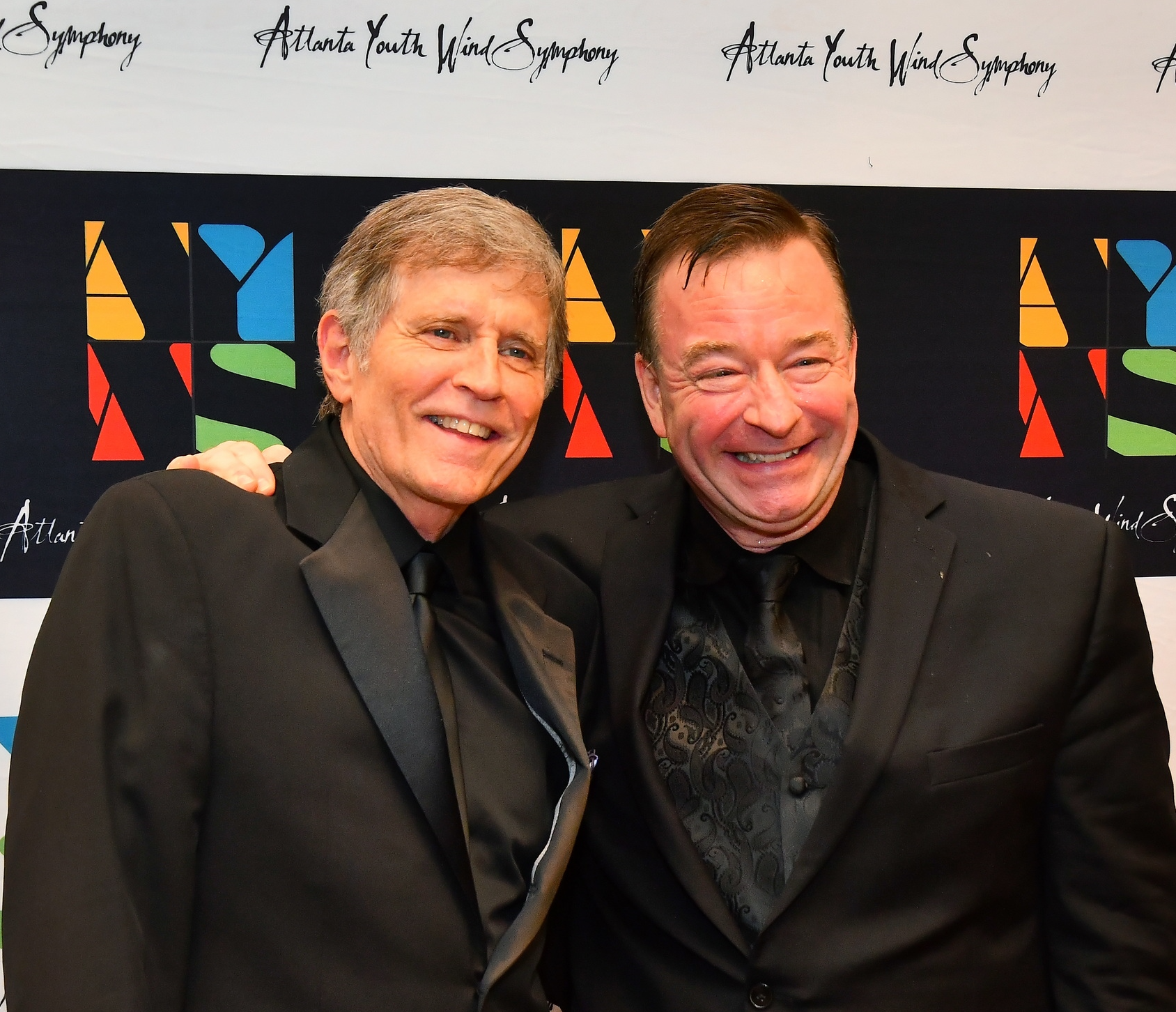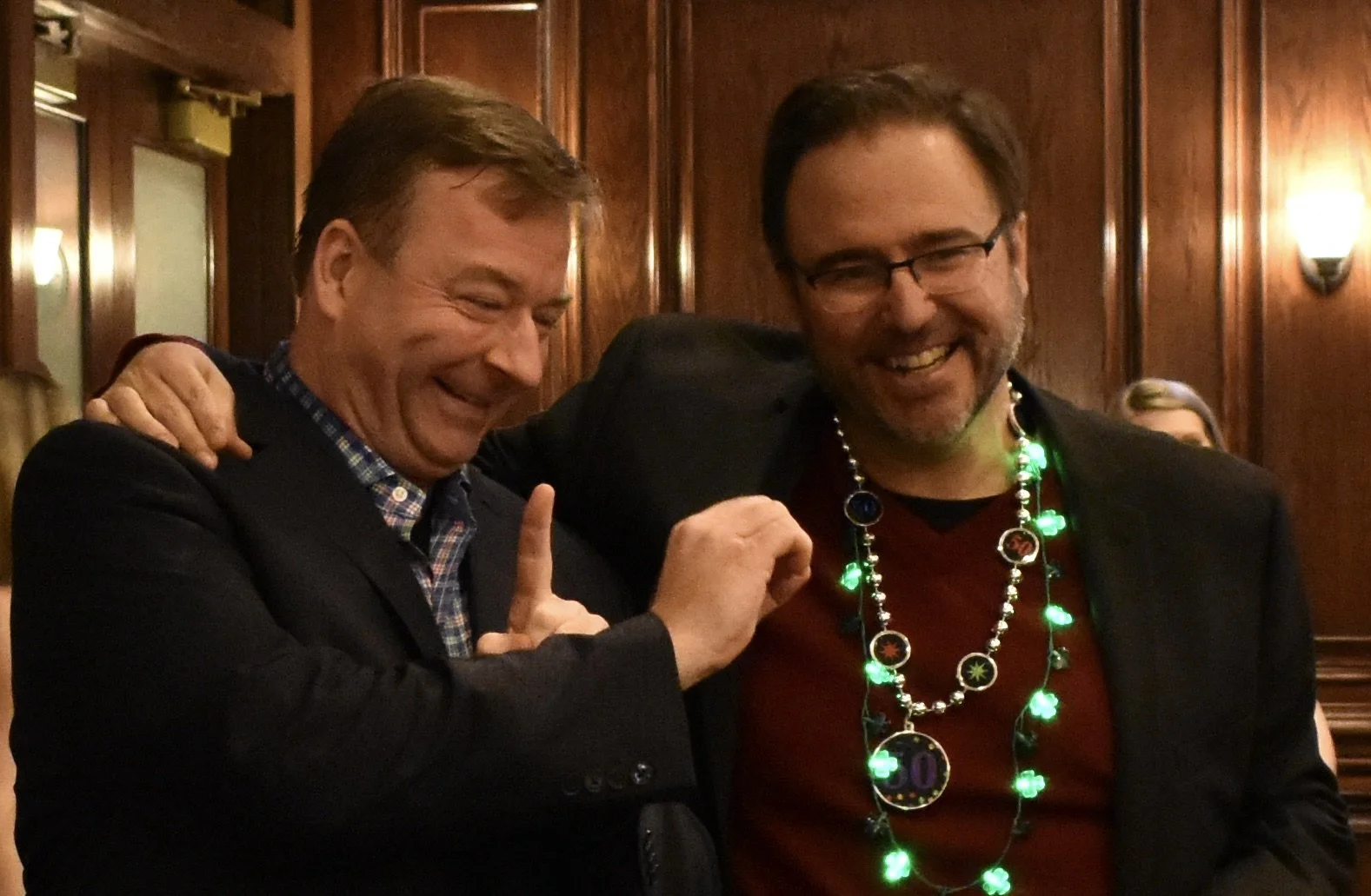ATLANTA YOUTH WIND SYMPHONY
Wednesday, May 14, 2025 4:00 PM
Atlanta Symphony Hall
Dr. Stewart with composer Christopher Theofanidis in 2007.
OFF THE CLOCK
Christopher Theofanidis
From the original program notes by the composer:
It is a pleasure to combine an artistic project with a personal friendship. Such is the origin of this work, celebrating the 30th anniversary of AYWS. Scott Stewart and I go back quite a long time to his Emory days, and we have had many professional collaborations over the years and have developed a close friendship. It was a particular pleasure then for me to write this work.
Off the Clock is a set of five miniatures lasting about twelve minutes, for concert band:
I. Allegro
II. Grazioso
III. Allegro
IV. Cantabile
V. Presto
Several of the movements elide into each other without distinct breaks. The first, third, and fifth movements are all very upbeat with strong rhythmic components. The second and third are more lyrical and coloristic. The first movement is based around a two-note motive and has a strong and driving percussion component. The second movement has slow, falling intervals in the muted brass and winds, with melodies emerging from the oboes and saxophones. The third movement is a fantasy on a Spanish medieval hymn. It exists in a kind of Renaissance sound world. The fourth movement is wistful with a long melodic line that leaves harmonic trails in its wake. The last movement is a peppy number with bright scoring. All the movements have some aspect of celebration at their core, and it has been a real pleasure to celebrate with AYWS in these weeks. I wish you all many more decades of such great music making!
– Christopher Theofanidis
Christopher Theofanidis is an award-winning composer and professor of composition at the Yale University School of Music. He holds degrees from Yale, the Eastman School of Music, and the University of Houston. You may visit his website at theofanidismusic.com.
SWEET LIKE THAT
Christopher Theofanidis
Sweet Like That was written to be a fun, exciting new piece for band. The piece incorporates requests from students at Betsy Ross Arts Magnet School with whom Mr. Theofanidis workshopped the piece.
The title of this work comes as a response to the students’ love of jazz titles. Theofanidis looked to the work of the great jazz cornet player, King Oliver, Louis Armstrong’s teacher, and one of the great pioneers of ‘hot jazz’ (where soloists improvise collectively). He wrote a piece called, “Sweet like this.”
Of Sweet Like That, Bandquest series editor Thomas C. Duffy wrote, “It is exuberant, joyful, with a whiff of gospel – it is sound of the American street, instrumental doo-wop; an urban march.”
Handel in the Strand
Percy Aldridge Grainger
Handel in the Strand is one of Grainger’s early light orchestral pieces, written in 1911, before he enlisted in the U.S. Army during World War I (as a saxophonist). Grainger had no trouble allowing other musicians to arrange his music to suit their needs, so Handel in the Strand has existed in several different versions. After its original massed piano and string orchestra setting came versions for full orchestra, piano (solo and 4 hands), organ, trombone choir, and two different settings for band (Goldman and Sousa).
”My title was originally Clog Dance. But my dear friend William Gair Rathbone (to whom the piece is dedicated) suggested the title Handel in the Strand, because the music seemed to reflect both Handel and the English musical comedy (the "Strand" – a street in London – is the home of London musical comedy) – as if jovial old Handel were careering down the Strand to the strains of Modern English popular music.” (Percy Grainger)
Faeroe Island Dance
Percy Aldridge Grainger
High and rugged, profiled by great cliffs and narrow ravines, the Faeroe Islands of the North Atlantic are populated by a gentle and simple people. From the native folk-music heritage of this distant land, Percy Grainger chose the lovely, flowing folksong Let's Dance Gay in Green Meadow for his glittering setting for concert band.
Faeroe Island Dance [finished February 21, 1946] is taken from the native folk-music heritage of the Faeroe Islands of the North Atlantic Ocean. On Sundays there were two locations in the town where the local villagers danced. In one area there were the Faeroe Dances and in the other the members of the Torshavn Wind Orchestra played the Tyrolean waltz, Swedish masquerade, Rhinelander, mazurka, and other waltzes and polkas for the village. Dancing to instrumental music in these islands dates back to the 17th century.
This piece is dedicated to the memory of Grainger's friend, the great portrait painter John Singer Sargent, who loved the Faeroe Island music.
Molly on the Shore
Percy Aldridge Grainger
Based on two Cork Reel tunes, Molly on the Shore and Temple Hill, respectively, Molly on the Shore began as a string quartet and was later rescored by Grainger himself for full symphony orchestra, chamber orchestra, and finally military band in 1920.
”In setting Molly on the Shore I strove to imbue the accompanying parts that made up the harmonic texture with a melodic character not too unlike that of the underlying reel tune. Melody seems to me to provide music with initiative, whereas rhythm appears to me to exert an enslaving influence. For that reason I have tried to avoid regular rhythmic domination in my music -- always excepting irregular rhythms, such as those of Gregorian chant, which seem to me to make for freedom. Equally with melody, I prize discordant harmony, because of the emotional and compassionate sway it exerts.” (Percy Grainger)
Composer Frank Ticheli with Dr. Stewart in December 2024.
Composer Frank Ticheli works with AYWS in 2008 during a pre-publication “test run” of Angels in the Architecture.
Over the Moon
Frank Ticheli
Much as in the epic tales pf Jules Verne's from the Earth to the Moon and George Méliès' iconic 1902 film A Trip to the Moon, I sought to take the listener on a brief musical voyage Over the Moon. At the start, the listener rides down a steep slide to the surface of the moon. At once a tango-like dance, glittery and light as silk, swims through the air. Instrumental solos appear and disappear like the characters of a story.
Suddenly the dance takes a on forbidding quality – plunger-muted growls appear as the work propels itself forward. Perhaps this is the dark side of the moon. Lines intermingle, the work lifts itself: Over the Moon, in joyful exuberance.
At the halfway mark, there is a brief respite, as if looking forward toward the peaceful blue planet: a hymn to life, to the Earth, the Moon, and towards the boundless energy of the Universe. A lone clarinet connects us to the return of the dance, reaching ever higher and brighter. A triumphant climax is suddenly quashed by a steep slide, back down to life on Earth. (Frank Ticheli)
Dr. Stewart and Dr. Theofanidis celebrate their joint 50th (combined 100 years!) birthdays together in Atlanta.
I wander the world in a dream of my own making
Christopher Theofanidis
When Robert Rumbelow approached me to write a piece for wind ensemble for this wonderful consortium commission, I was really delighted, as I had been thinking of a piece for these forces for some time and was eager to try some of the acoustic things that I do in my pieces for symphony orchestra in a different context. I have long been interested in the idea of trying to “build in” an acoustic into my orchestrations; that is, to create the effect, for instance, of a melody which has a sense of sustain as if it were being played in a cathedral even though it is not -- to build that reverberation into the orchestration. I was very pleased to see that not only could I achieve similar effects but also different and even more exciting things with various combinations of winds, brass, and percussion.
The title for this work is a reference to the compositional process. Writing a piece of music is like creating a dream that you want to have. The feeling that pervades the work is one of a sense of mystery, and this sentiment is primarily conveyed through the harmonies and orchestration.
The work is based on two ideas: the first is a short, two-note motive, and the second is a descending melody of five notes, ending in the repetition of the final note several times. This second material could be called the main melody, and it always appears shrouded in a kind of haze, until toward the very end of the work.
This work received its premiere performance by the Columbus State University (Columbus, GA) Wind Ensemble, conducted by Robert Rumbelow, in April 2006.
Composer Ron Nelson with Dr. Stewart during an AYWS residency in 2002.
Rocky Point Holiday
Ron Nelson
Rocky Point Holiday was a commission from Frank Bencriscutto and the University of Minnesota band for a tour of Russia. It was composed between 1968 and 1969. Bencriscutto had heard Nelson's orchestral work Savannah River Holiday and decided he wanted something virtuosic to take with him on the Russian tour. When asked about the limitations of the band, Bencriscutto told him there were none. "I'm going to write a tremendously difficult piece," Nelson warned him. "That's fine," replied Bencriscutto, and thus Rocky Point Holiday was born. Nelson says, "This was a pivotal moment in my notion of wind ensemble scoring, in which I focused on orchestrating in an extremely transparent way."
The bulk of the work on the composition occurred while Nelson was on vacation at a Rhode Island seaside resort. Rocky Point is an amusement park over a hundred years old, located in Warwick Neck, RI. It was closed down in the mid-1990s due to a lack of funds.






